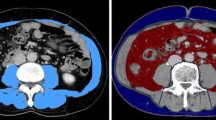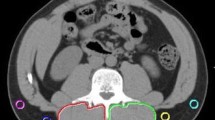Abstract
Purpose
To evaluate the effect of body composition on outcomes after hepatic resection for patients with hepatocellular carcinoma (HCC).
Methods
We performed 190 hepatic resections for HCC and divided the patients into 2 groups on the basis of visceral fat area (VFA), assessed by computed tomographic measurement at the level of the umbilicus, into high VFA (H-VFA) (n = 106) and low VFA (L-VFA) (n = 84) groups. We compared the surgical outcomes between the two groups.
Results
L-VFA was significantly correlated with a lower body mass index, sarcopenia, lower serum albumin, and liver cirrhosis. There was no difference in the incidence of postoperative complications and mortality between the 2 groups. Patients in the L-VFA group had a significantly poorer prognosis than those in the H-VFA group in terms of both overall (P = 0.043) and recurrence-free (P = 0.001) survival. The results of multivariate analysis showed that sarcopenia rather than L-VFA was an independent and prognostic indicator after hepatic resection with HCC.
Conclusions
Body composition is an important factor affecting cancer outcomes after hepatic resection for HCC in Japan.


Similar content being viewed by others
References
Bruix J, Lovet JM. Prognostic prediction and treatment strategy in hepatocellular carcinoma. Hepatology. 2002;35:519–24.
Bosch FX, Ribes J, Díaz M, et al. Primary liver cancer: worldwide incidence and trends (review). Gastroenterology. 2004;127:S5–16.
Takenaka K, Kawahara N, Yamamoto K, et al. Results of 280 liver resections for hepatocellular carcinoma. Arch Surg. 1996;131:71–6.
Shirabe K, Takeishi K, Taketomi A, et al. Improvement of long-term outcomes in hepatitis C virus antibody-positive patients with hepatocellular carcinoma after hepatectomy in the modern era. World J Surg. 2011;35:1072–84.
Itoh S, Morita K, Ueda S, et al. Long-term results of hepatic resection combined with intraoperative local ablation therapy for patients with multinodular hepatocellular carcinomas. Ann Surg Oncol. 2009;16:3299–307.
Yamashita Y-i, Taketomi A, Itoh S, et al. Longterm favorable results of limited hepatic resections for patients with hepatocellular carcinoma. J Am Coll Surg. 2007;205:19–26.
Itoh S, Fukuzawa K, Shitomi Y, et al. Impact of the VIO system in hepatic resection for patients with hepatocellular carcinoma. Surg Today. 2012;42:1176–82.
Uchiyama H, Itoh S, Higashi T, et al. A two-step hanging maneuver for a complete resection of Couinaud’s segment I. Dig Surg. 2012;29:202–5.
Taketomi A, Kitagawa D, Itoh S, et al. Trends in morbidity and mortality after hepatic resection for hepatocellular carcinoma: an institute’s experience with 625 patients. J Am Coll Surg. 2007;204:580–7.
Itoh S, Shirabe K, Taketomi A, et al. Zero mortality in more than 300 hepatic resections: validity of preoperative volumetric analysis. Surg Today. 2012;42:435–40.
Merkow RP, Bilimoria KY, McCarter MD, et al. Effect of body mass index on short-term outcomes after colectomy for cancer. J Am Coll Surg. 2009;208:53–61.
Mullen JT, Davenport DL, Hutter MM, et al. Impact of body mass index on perioperative outcomes in patients undergoing major intra-abdominal cancer surgery. Ann Surg Oncol. 2007;15:2164–72.
Itoh S, Ikeda Y, Kawanaka H, et al. The effect of overweight status on the short-term and 20-y outcomes after hepatic resection in patients with hepatocellular carcinoma. J Surg Res. 2012;178:640–5.
Sugisawa N, Tokunaga M, Tanizawa Y, et al. Intra-abdominal infectious complications following gastrectomy in patients with excessive visceral fat. Gastric Cancer. 2012;15:206–12.
Cecchini S, Cavazzini E, Marchesi F, et al. Computed tomography volumetric fat parameters versus body mass index for predicting short-term outcomes of colon surgery. World J Surg. 2011;35:415–23.
Harimoto N, Shirabe K, Yamashita YI, et al. Sarcopenia as a predictor of prognosis in patients following hepatectomy for hepatocellular carcinoma. Br J Surg. 2013;100:1523–30.
Kvist H, Chowdhury B, Sjöström L, et al. Adipose tissue volume determination in males by computed tomography and 40 K. Int J Obes. 1988;12:249–66.
Yoshizumi T, Nakamura T, Yamane M, et al. Abdominal fat: standardized technique for measurement at CT. Radiology. 1999;211:283–6.
Pringle JH. Notes on the arrest of hepatic hemorrhage due to trauma. Ann Surg. 1908;48:58–62.
Clavien PA, Barkun J, de Oliveira ML, et al. The Clavien-Dindo classification of surgical complication: five-year experience. Ann Surg. 2009;250:187–96.
World Health Organization. Obesity: preventing and managing the global epidemic. Geneva, Switzerland: World Health Organization; 2000.
Kashihara H, Lee JS, Kawakubo K, et al. Criteria of waist circumference according to computed tomography-measured visceral fat area and the clustering of cardiovascular risk factors. Circ J. 2009;73:1881–6.
Mano Y, Shirabe K, Yamashita Y, et al. Preoperative neutrophil-to-lymphocyte ratio is a predictor of survival after hepatectomy for hepatocellular carcinoma: a retrospective analysis. Ann Surg. 2013;258:301–5.
Shirabe K, Itoh S, Yoshizumi T, et al. The predictors of microvascular invasion in candidates for liver transplantation with hepatocellular carcinoma—with special reference to the serum levels of des-gamma-carboxy prothrombin. J Surg Oncol. 2007;95:235–40.
Itoh S, Maeda T, Shimada M, et al. Role of expression of focal adhesion kinase in progression of hepatocellular carcinoma. Clin Cancer Res. 2004;10:2812–7.
Takeishi K, Taketomi A, Shirabe K, et al. Diacylglycerol kinase alpha enhances hepatocellular carcinoma progression by activation of Ras-Raf-MEK-ERK pathway. J Hepatol. 2012;57:77–83.
Gaujoux S, Torres J, Olson S, et al. Impact of obesity and body fat distribution on survival after pancreaticoduodenectomy for pancreatic adenocarcinoma. Ann Surg Oncol. 2012;19:2908–16.
Saunders JK, Rosman AS, Neihaus D, et al. Safety of hepatic resections in obese veterans. Arch Surg. 2012;147:331–7.
Dindo D, Muller MK, Weber M, et al. Obesity in generalelective surgery. Lancet. 2003;361:2032–5.
van Vledder MG, Levolger S, Ayez N, et al. Body composition and outcome in patients undergoing resection of colorectal liver metastases. Br J Surg. 2012;99:550–7.
Hotamisligil GS. Inflammation and metabolic disorders. Nature. 2006;444:860–7.
Sacks GS, Dearman K, Replogle WH, et al. Use of subjective global assessment to identify nutrition-associated complications and death in geriatric long-term care facility residents. J Am Coll Nutr. 2000;19:570–577.
Pausch T, Hartwig W, Hinz U, et al. Cachexia but not obesity worsens the postoperative outcome after pancreatoduodenectomy in pancreatic cancer. Surgery. 2012;152(3 Suppl 1):S81–8.
Rolland Y, Czerwinski S, Abellan Van Kan G, et al. Sarcopenia: its assessment, etiology, pathogenesis, consequences and future perspectives. J Nutr Health Aging. 2008;12:433–450.
Lang T, Streeper T, Cawthon P, et al. Sarcopenia: etiology, clinical consequences, intervention, and assessment. Osteoporos Int. 2010;21:543–59.
Author information
Authors and Affiliations
Corresponding author
Rights and permissions
About this article
Cite this article
Itoh, S., Shirabe, K., Matsumoto, Y. et al. Effect of Body Composition on Outcomes after Hepatic Resection for Hepatocellular Carcinoma. Ann Surg Oncol 21, 3063–3068 (2014). https://doi.org/10.1245/s10434-014-3686-6
Received:
Published:
Issue Date:
DOI: https://doi.org/10.1245/s10434-014-3686-6




